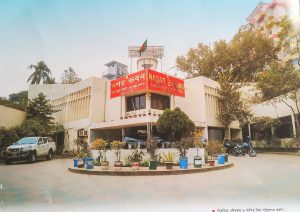Reviving Heritage, Enriching Community:

The Rise of Cultural Activity Development in Comilla City
Culture is the soul of a city. It defines the rhythm of daily life, binds communities through shared values, and offers a sense of belonging that concrete and infrastructure alone cannot provide. In the ancient and vibrant city of Comilla, where history whispers through archaeological sites and local traditions, culture is not just a legacy—it is a living, evolving force.
In recent years, the Comilla City Corporation (CuCC) has taken commendable steps to revitalize cultural activities as a core part of urban development. Recognizing that sustainable progress is not possible without social cohesion, creative expression, and preservation of heritage, CuCC is weaving culture into the fabric of city governance.
This article explores the city’s evolving cultural scene, the efforts of CuCC to promote cultural engagement, and how these initiatives are strengthening identity, inclusion, and community resilience in Comilla.

Comilla’s Rich Cultural Landscape
Comilla boasts a cultural identity shaped by thousands of years of history. From the Buddhist ruins of Mainamati to the melodies of Nazrul Sangeet, the city has long been a center of spiritual, intellectual, and artistic activity. It is also home to legendary poets, education reformers, freedom fighters, and folk artists.
Yet, with urban expansion and changing lifestyles, traditional forms of cultural expression were at risk of fading. Recognizing this, CuCC is taking active steps to ensure that cultural life not only survives but thrives in the modern age.
Key Areas of Cultural Activity Development
- Revitalizing Heritage Sites
Comilla is rich in archaeological treasures such as:
- Shalban Vihara
- Kutila Mura
- Charpatra Mura
- The ancient forts and colonial-era buildings
CuCC works in partnership with national agencies and cultural organizations to:
- Protect these sites from encroachment and degradation
- Improve tourist access through signage, lighting, and sanitation
- Promote local tourism that respects and educates about cultural heritage
By integrating heritage protection into city planning, Comilla is celebrating its past while educating new generations.

- Establishing Cultural Centers and Complexes
To promote regular cultural activity, CuCC has initiated or supported the development of:
- Community Cultural Halls for hosting plays, musical events, book fairs, and debates
- Ward-level open-air stages for folk performances, religious festivals, and poetry recitals
- City Cultural Complex (proposed) that would include exhibition galleries, an auditorium, and a library
These spaces provide platforms for local artists, youth, and cultural groups to perform, collaborate, and grow.

- Supporting Performing Arts and Folk Traditions
Comilla is a cradle of traditional music, dance, and storytelling. CuCC has taken steps to:
- Sponsor Baul, Nazrul, and Lalon music events at key festivals
- Collaborate with schools to reintroduce cultural education
- Offer grants or stipends to struggling local artists and cultural groups
Through this, the city is not only preserving fading art forms but also giving economic value to cultural work.

- Celebrating Festivals and Civic Traditions
Annual events are vital to building citywide unity and celebrating shared identity. CuCC plays a central role in organizing:
- Victory Day and Independence Day celebrations
- Language Martyrs’ Day (21 February) observances
- Bengali New Year (Pohela Boishakh) processions and fairs
- City Day events, showcasing Comilla’s history and civic pride
These events foster intergenerational connection, cultural literacy, and public participation.
- Engaging Youth Through Culture
Young people are central to cultural continuity and innovation. CuCC collaborates with schools, colleges, and youth clubs to:
- Host debate competitions, art contests, recitation events, and digital storytelling
- Launch creative writing and film-making workshops
- Recognize young cultural talents with awards and scholarships
By integrating youth into cultural planning, the city ensures a vibrant cultural future.

Community Impact: More Than Just Entertainment
Cultural development has deep social and economic benefits:
✅ Social Cohesion
Cultural events bring together people from different backgrounds, building unity in diversity. In a city like Comilla—with its mix of urban, rural, Hindu, Muslim, and tribal communities—this cohesion is essential.
✅ Mental Well-Being
Music, dance, art, and festivals serve as emotional outlets and promote mental health—especially important in the post-COVID era.
✅ Tourism and Economic Opportunity
Heritage tourism and cultural festivals attract visitors, boosting small businesses, craftspeople, and food vendors.
✅ Identity and Civic Pride
A strong cultural identity deepens people’s connection to their city, encouraging better civic behavior, environmental responsibility, and social participation.

Challenges to Cultural Growth
While progress is being made, several obstacles remain:
▪ Lack of Permanent Cultural Infrastructure
There is a need for more cultural halls, art studios, and museums at the ward and city levels.
▪ Funding Constraints
Regular support for cultural groups and events depends on stable, transparent funding.
▪ Cultural Erosion
Global media, social pressures, and migration can erode traditional cultural values and expressions.
▪ Inclusion Gaps
Marginalized voices—such as tribal cultures, disabled artists, or female performers—may still be underrepresented.
Addressing these requires long-term planning, multi-stakeholder partnerships, and policy support.
The Way Forward: Cultural Planning as Urban Strategy
Comilla City Corporation has the opportunity to embed culture into its broader development strategy. This can include:
- Establishing a City Cultural Council with artists, educators, youth, and elders
- Incorporating cultural planning into urban master plans
- Promoting cultural tourism with branded city festivals
- Developing a digital archive of Comilla’s cultural history, music, poetry, and oral traditions
- Using public art to beautify city spaces with murals, sculptures, and historical storytelling
These steps will ensure that culture becomes not just an add-on, but a core pillar of urban sustainability.
Culture is not a luxury—it is a necessity for a humane, harmonious, and vibrant urban life. In Comilla, where ancient history meets modern challenges, the City Corporation’s commitment to cultural activity development is a beacon of hope.
Through strategic investments, inclusive programming, and citizen participation, CuCC is proving that culture can be a powerful tool for development, dignity, and democracy.
As Comilla moves forward, its cultural heartbeat will remain central—not only to its identity but to its progress as a truly livable and lovable city.
www.asianstate.net, asian.state48@gmail.com
Official facebook Page:Asian State International Journal

